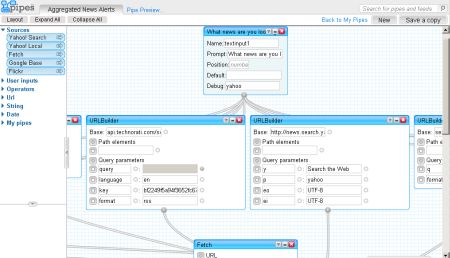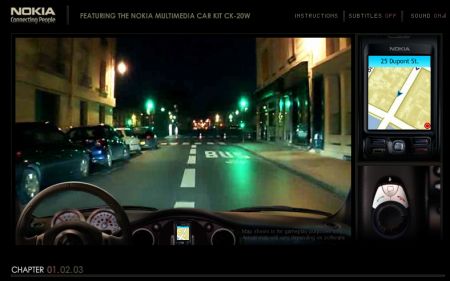von Roland Hachmann | März 20, 2007 | Blog, Digital Culture, Marketing, Marketing Trends, SEO / SEA, Social Media Marketing
I know I am fairly late with this, but this is absolutely astounding! Yahoo! Pipes let’s users create their own feeds based on any information on the web. Here is an example of a meta-search-feed:
The pipe you’re looking at demonstrates how to use a few of the more powerful modules. In this example a variety of sources are queried with the same term. The results are merged into one feed. Next, all the items are sorted by what was most recently published. Finally any items with identical titles are removed and a new RSS feed is born.
This is how it looks like:

Once you have created a pipe, you can subscribe to the feed via the usual suspects – bloglines in my case.
Apparently you can meshup all sorts of types of information. A popular one for example is a mixture of appartments for rent and google maps.
A fascinating example of how „plattforms“ and „programming“ become less important, because users only meshup what is of interest to them any way. Question is: how can marketers make sure that users still receive marketing messages? (And like receiving them, at the same time – that will be even more important!)
von Roland Hachmann | März 11, 2007 | Ad News, Blog, Digital Marketing, Marketing, Marketing Trends, Online Advertising, SEO / SEA, Social Media Marketing
This seems interesting and obvious at the same time – a study about user revolution:
The report defines user revolution as a major trend that is happening primarily with consumers, who are taking control of content consumption and branding. The historically passive consumer is changing rapidly, not only becoming more informed and confident about purchase decisions, but also increasingly taking control of the consumption of information and content that used to be distributed by networks, studios, publishers and retailers […] We believe this will cause a significant rise in prominence of the Internet as a major content consumption and marketing medium.
The „news“ is from a report by Piper&Jaffrey. They list 12 key findings, such as predicted online advertising growth rates over the next few years (around 20% per year), the rise of communitainment (careful: new buzzword!), the rise of Usites (another one!) – sites with user generated content, and the increase of video ads.
At the end, they list the companies most likely to profit from these trends:
Google (and YouTube), Yahoo!, Disney, News Corp., Time Warner, Microsoft, InterActive, Facebook, Craigslist, Brightcove, Yelp, SINA Corp., Baidu, aQuantive, ValueClick, 24/7 Media, Netflix, Wikipedia, MobiTV, Digg and Hakia.
von Roland Hachmann | März 4, 2007 | Ad News, Blog, Marketing
It is common knowledge, that we are moving away from pure interruption advertising on to engagement marketing. Or something along those lines.
In order to engage users and invite them to check out the latest advertising, companies now seem to use YouTube to announce advertising campaigns. Here is the latest example of Adidas telling us that a new segment of the „impossible is nothing“ campaign will start on the 6th of March (so stay tuned!!)
https://www.youtube.com/watch?v=D67LVlXIrr4
I just wonder: who – except for us working in advertising – is really bothered if and when a campaign starts?
von Roland Hachmann | März 1, 2007 | Blog, Marketing
David Armano of Logic+Emotion tells us an interesting story:
When Arnold Schwarzenegger first came to the United States, he started a small bricklaying business with fellow bodybuilder and immigrant Franco Columbu. The business wasn’t off to a good start.
They quickly re-invented their business model into a service that was much more expensive than the competition and sold themselves in a way that played up their European heritage. They would seduce their LA customers by saying that their method of bricklaying was different because it was „Austrian Bricklaying“.
I didn’t know this. Neither did I know, that Arnold worked as a bricklayer, neither did I know, that he was such a clever guy in marketing. Or was it only his fellow bodybuilder? But then, it’s Arnold, who’s now a Governor, isn’t he?
David Armano, bringing us back to marketing, concludes:
- Sometimes the best marketing involves exaggerating certain „truths“
- Occasionally brands are built not from strengths, but from turning perceived weakness into strength
And asks us:
Have you figured out what your weakness is? Is there a way to turn it into a differentiating strength?
von Roland Hachmann | Feb. 28, 2007 | Ad News, Blog, Digital Marketing, Marketing, Online Advertising
Adfreak points me to a nice Nokia Advergame. You are the driver of a French Lady who apparently needs to take care of some dubious business in Paris. So you drive her around the beautiful city:
Instead of re-creating the city using computer animation, they shot actual footage on the Ile St. Louis. While you’re driving, you can fool around with Nokia’s car kit by using its GPS features and changing the music.
On the site, it takes ages until the game has loaded…
And the game controls seem a little sluggish – but maybe it’s just my PC.
And it’s well worth it. The grafics are brilliant, and having lived in Paris for a year, I actually recognised most of the spots.



 Wo ich sonst so bin...
Wo ich sonst so bin...